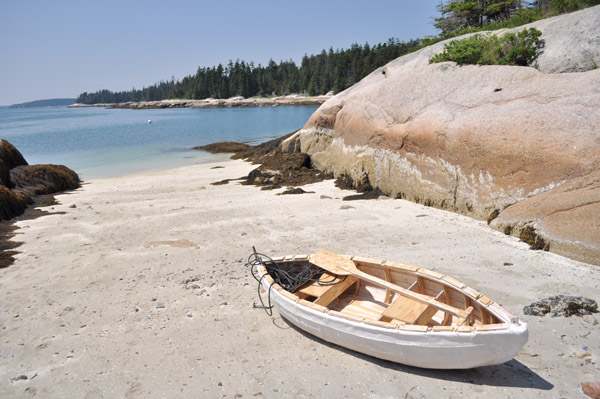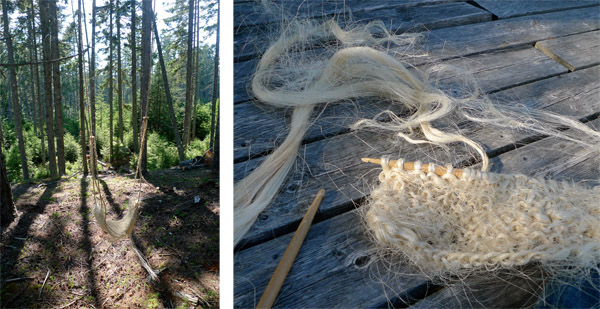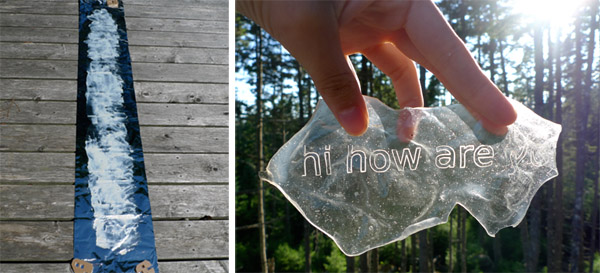Friendly composites at Haystack
July 13th, 2010Tags: composites, crafts, deer isle, fablab, green, haystack, haystack mountain school of crafts, maine, polyurethane, visiting scientist
Special thanks to Stu, Eugene, Mis, Jonathan D, Stephen, Dan and the rest of the Haystack crew for inviting Neil up as a ‘visiting scientist’ and hanging out with us. Also thanks to Neil for letting me be a Fablab TA, even if it did mean that Jonathan and I had to haul a 4×4 foot shopbot in and out of his house. And finally thanks to Grace for teaching me how to hula hoop. She gave me the key insight that a hoop must be driven in a circle, not by swinging the hips from side to side. To better approximate a circle, I started with hula hooping standing on one foot, eliminating the two elliptical foci your feet otherwise form together.
I went back to Haystack Mountain School of Crafts for a wonderful week of craft, fablab, guitar, volleyball and lobster. Also the Deer Isle Independence day parade, in which I again found myself a sea creature.
My master’s thesis is on rapid prototyping with friendly materials: especially composites, which allow making large, light and strong structures. Going to Haystack involved me bringing several bales of natural fibres: sisal, cotton, hemp & kenaf; many gallons of low-VOC emitting polyurethanes and other 2 part plastics; and also some starches and proteins to try the less-durable kind of resin. At Haystack, I was going to experiment with what we could make with those materials and how they were to handle.

Leslie Tharp and Matt Bissett took Matt Hinçman’s mixed media session and made this amazing boat. They used the heavy duty cotton canvas and a polyurethane resin (smooth-on’s smoothcast 305) over a wooden shell. They did the entire thing in about 2 days, including the design.
Tom Spleth is a ceramicist who makes plaster positives, working with the plaster as it is setting to create architectural forms he later casts as porcelain. Here is a video I stole from Tim Ayer’s blog of Tom’s process of working with curing plaster:
Tom and Juan Torres took to the visiting artist’s studio deck to try to see what forms would emerge from them taking a similar approach with the same cotton canvas and polyurethane Leslie and Matt were using for the boat. Tom and Juan used the ultra-fast setting polyurethane, so that they could hold the canvas in place as it cured and thus shape a form.

Tom Spleth, friendly composites and Eames

Tom & Juan’s molding hands, discarded in the process
The canvas fabric is not ideal– better would be a more thinly woven fabric applied in more plies. Cotton however, is not a very strong fibre and might not withstand the process well if it were much thinner. A lot of the stalk and bast fibres I’m using are very strong– the sisal I use is on par with fibreglass for strength in tension. However, if set in a epoxy that cures at a high temperature, the fibres become damaged and do not work as well. Furthermore, it not easy to get cellulose fibres in nice weavings and tapes like carbon and glass fibres come in, so prototyping is limited.

Either way, with the raw unchopped sisal fibres I had, I knitted a swing while waiting for fab machines to finish running and my code to load onto the slow-ass avrs I was programming. I knitted using drumsticks that we also used for playing late night country music. My new favourite song is Jonathan Ward singing just because you’re better than me, doesn’t mean I’m lazy.
The swing however, is not a composite, or a particularly cool process. I’m not super enthusiastic about using the polyurethane– even though the polyurethane is not super toxic or bad to work with, it is hard to recycle and lasts for much longer than its general intended purpose. I’ve been trying different low-tech resin recipes, making corn starch and soy protein films, and melting tree sap roisins. Unfortunately the films dissolve immediately in water and the roisins remain sticky after the process.

You can however, laser cut the film.
